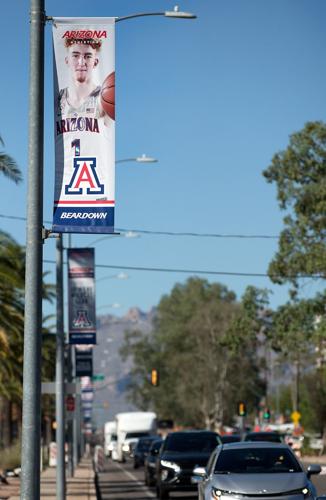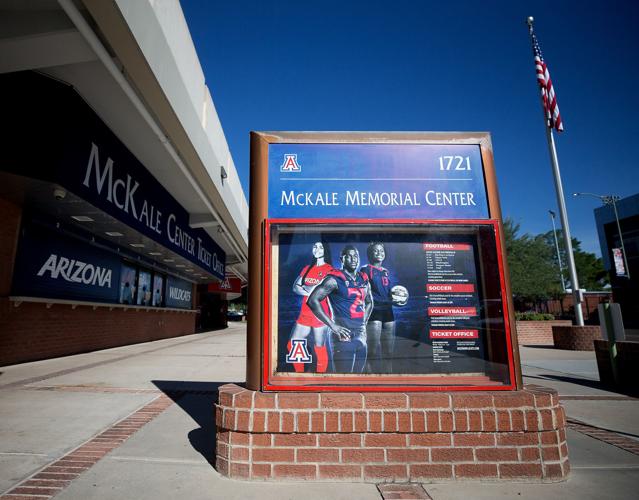A colorful banner featuring Arizona freshman point guard Nico Mannion is mounted on a utility pole on North Campbell Ave., about 100 yards from McKale Center. This is how much money Mannion receives for the use of his likeness: $0.
Near the ticket office outside McKale Center, Arizona All-Pac-12 running back J.J. Taylor is pictured in an advertisement for season tickets. Taylor is not compensated for the ad.
Beginning in 2023, high-profile athletes like Mannion and Taylor who play for any of the 58 universities in California will be able to demand payment for such use of their name, image and likeness.
When California governor Gavin Newsom signed SB 206 into law Monday, it was NCAA’s equivalent of the eruption of Mount Vesuvius. Over the next few years, SB 206 will inevitably blow up the amateurism model of college athletics, here and everywhere.
For example: When Arizona’s women’s basketball team staged an epic 6-0 run to win the Women’s NIT last year, selling out McKale Center, dynamic point guard Aari McDonald became an instant celebrity in this town.
Had McDonald announced she would be signing autographs for $10 at Dick’s Sporting Goods in the Tucson Mall, it’s not an exaggeration to think she could’ve pocketed $10,000 from fans and maybe another $5,000 from Dick’s.
Imagine what Nico Mannion could make if Jim Click Automotive made him the centerpiece of a pre-Christmas marketing campaign. Do I hear $50,000, plus a free SUV?
Arizona athletic director Dave Heeke says that the “amateurism model is outdated” but adds this very important qualifier: “We just can’t say, ‘let them sell their jerseys.’”
Can you imagine how much money Khalil Tate’s jersey No. 14 might’ve generated in the 2017 season, when for one magic month he became a quarterback superman? Let’s start the estimates at $25,000.
At issue is the NCAA’s rule that the 500,000 student-athletes at its 1,050 member schools are equals.
The potential problems are of great magnitude.
If Arizona’s world-class diver Delaney Schnell could earn $40,000 a year giving clinics and speaking to aspiring Olympic divers, is that fair to the other divers at the UA?
“We have 500 student-athletes,” says Heeke. “You soon get to fairness.”
Then there’s recruiting.
What’s keeping the UA — or any school — from promising a 5-star recruit that its boosters will take care of him, legally, when arrives on campus? That athlete could charge exorbitant rates for a meet-and-greet or autograph, with the understanding that his school’s boosters will meet it. It won’t take long for some schools to take advantage of the system.
And just imagine how high the bidding could go when the mega-wealthy SEC football schools get involved in a recruiting chase. A new set of recruiting rules would need to be written.
UA coach Kevin Sumlin declined comment about SB 206 on Monday, except to say “I hope there’ll be a lot of different changes before 2023.”
Ohio State athletic director Gene Smith, part of the NCAA’s committee charged to recommend a response to SB 206, said that a school like Ohio State will simply not schedule California schools anymore.
“They won’t be members of the NCAA,” he said.
But that’s the least likely of all things that’ll happen with SB 206. The Pac-12 won’t implode. Over the next two or three years, the presidents and chancellors of America’s leading athletic institutions will surely move into the 21st century and give student-athletes unprecedented economic rights.
The regulation of those economic rights will be the tricky part.
“I like the overall spirit of the college model,” says Heeke, and so do I.
Here’s why: A few years ago, Arizona distance runner Lawi Lalang won eight NCAA championships and, in my opinion, was the most accomplished UA athlete of the last decade. In the summer before his senior year, 2013-14, Lalang could’ve pocketed thousands of dollars in appearance fees in Europe and at places like the Prefontaine Classic in Oregon.
I asked UA track coach Fred Harvey if he feared Lalang would take the money and bypass his senior year. Harvey shook his head, no.
“He would have to start paying for coaching,” said Harvey. ”He would no longer have free access to the medical treatment and the medical insurance he gets for free at Arizona. He has free access to strength coaches at McKale Center and, of course, he doesn’t pay a dime for his education.”
According to the UA’s online financial figures, an out-of-state student like Lawi Lalang gets full cost of attendance valued at $55,000 per year — $36,000 for out-of-state tuition, $13,000 for room and board, and $6,000 in various miscellaneous expenses.
What’s more, the UA employs 15 full-time academic counselors for athletes and has four full-time mental health counselors and psychiatrists. You want a free breakfast or lunch? That’s why the Bear Down Kitchen in the Lowell-Stevens football facility was created.
But there’s more. Lalang told me that one reason he remained at Arizona for all four years went beyond money and NCAA championships.
“(Assistant coach) James Li is more than a coach,” he said. “He mentored me and treated me like a son. Every tough decision I made, in academics and athletics, was influenced by him. When it comes to growing up, he has treated me like a man.”
That’s why I like the amateur model. College sports are about much more than winning the national title at 10,000 meters or getting to the Final Four and using that platform to become a first-round draft pick.
In the era of one-and-done ballplayers in Tucson, it’s easy to forget the value of an education.
The men and women who operate the NCAA, the conference commissioners and those like Heeke and his Pac-12 peers have two or three years to reconfigure the course of college athletics.
The elite athletes at Arizona and elsewhere will inevitably be compensated beyond the cost of attendance. As Bob Dylan sang “how many years can a mountain exist before it’s washed to the sea?”
The NCAA amateurism model is about to go under water.





